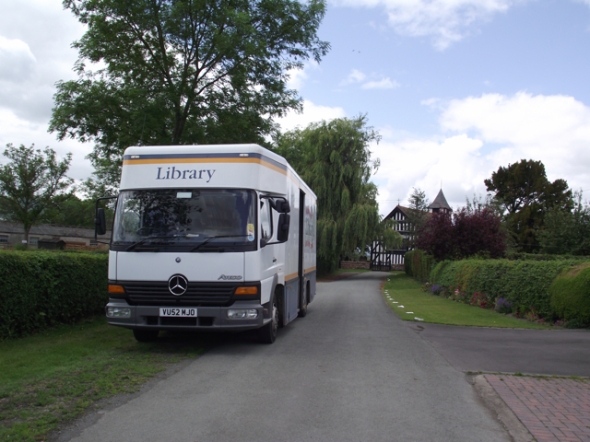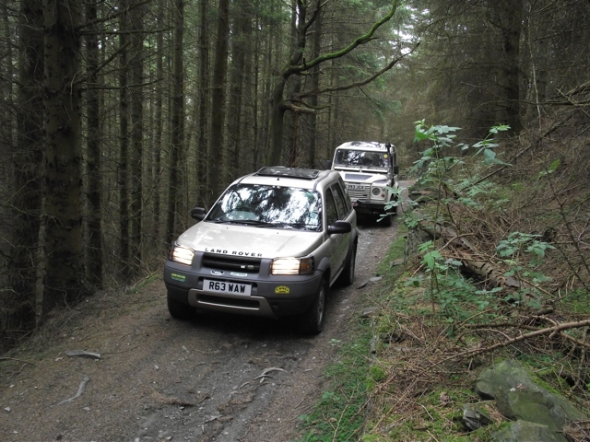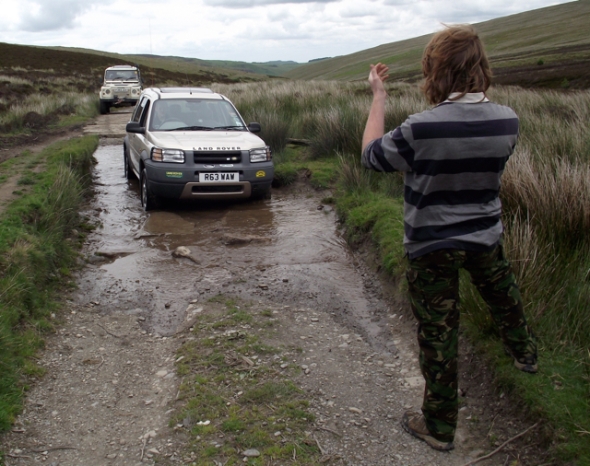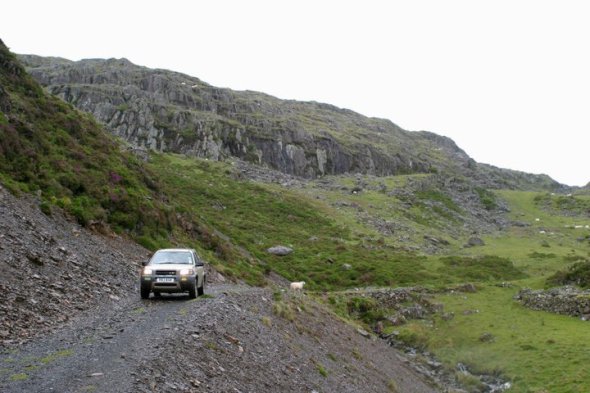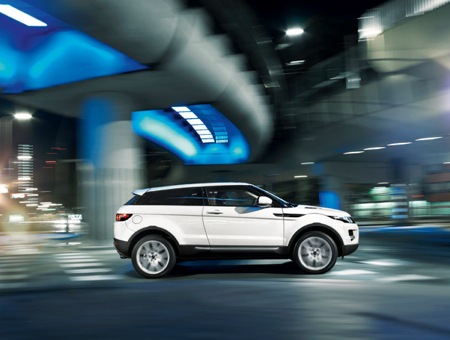A Day on the Oswestry Rural Mobile Library
Posted: July 2, 2011 Filed under: Uncategorized Leave a commentI must admit, I rarely visit the library. It’s not a conscious decision – I just rarely find the time. I do read a lot but it’s just too easy to find books I want on Amazon and have them delivered the next day.
But would I visit the library more often if it came to me?
The mobile library in North Shropshire does just that. It visits rural communities where, unlike in my case, the library isn’t just a 10 minute walk away.
I was eager to find out who uses the mobile library and how popular it is, so I joined driver Terry Alcock on one of his rounds.
We set off from Oswestry Library at 8.30am prompt and headed south along the A483 to our first stop in Llanymynech. The journey took no time at all and there are regular buses along the route into Oswestry – so is the mobile library purely for the lazy who can’t be bothered a trip to Oswestry?
While considering the answer to this question I started to notice a theme that would continue for the rest of the day. The majority of users who used the library are elderly and their highlight of the fortnight is when Terry visits the village in the mobile library.
Jumping on the bus to Oswestry sounds easy to you or me, but it’s not for a lot of these people. Terry provides them with a bit of banter, stamps, and of course a large selection of books to read.
Unfortunately the mobile library isn’t a hit everywhere. We pulled up in Pant where we had just one customer (who had driven to the mobile library).
Terry told me of the uproar in the village when they tried to move the stop into the car park of a nursery school.
“As soon as I pulled in I was approached by a woman going nuts saying it wasn’t safe for the kids. I suggested she brought them out to the library to have a look at the books but she wasn’t having it. We had to move back to the stop at the edge of the village.”
The Oswestry Rural mobile library alone costs in excess of £40,000 a year to run. When this is the welcome it gets, is it worth it?
Terry said: “The leases are coming to an end on the buses this year. With the cuts the council are making, will they renew them? Who knows.”
“Four drivers have been lost recently. They’re trying to cut back without hitting anyone too hard.”
I was sceptical to begin with. A huge chuck of money is being put into these mobile libraries which are driven around rural areas for just a handful of people.
But as the day went on, I met more and more people who would be lost without the library.
One of our last stops was in the village of Maesbrook. Terry looks forward to this stop as he is provided with a cup of tea and a slice of cake.
A group of villagers hold a coffee morning every two weeks in the village hall especially for the visit of the library. In winter up to 30 people turn up for a chat and to have a look at the books on offer. The contrast between here and Pant is astonishing.
Villager Nina Morgan said: “We would not do coffee mornings without the bus. We would be very lost without it.”
With the council making cuts left, right and centre the future of the mobile library is clearly under threat. But having met the people who use this resource it’s clear that it’s loss would be another nail in the coffin of our rural communities along with the decline of the village shop, post office and pub.
Next time I’m passing through a village that’s being visited by Terry or another driver in the mobile library, I’ll be sure to jump on board and borrow a book or two – whilst I still can.
Freelaning in North Wales
Posted: June 25, 2011 Filed under: Uncategorized 1 CommentNorth Wales is plagued with unsurfaced right of ways which are popular with off roaders, bikists, ramblists and other general outdoorsy types.
As a lazy outdoorsy type I’ve done all these lanes a number of times as a passenger in various friend’s 4x4s – especially in that of Don Parry, an off road instructor who works for Land Rover and therefore is a bit of an expert at pushing these vehicles to the extreme.
Don’s always been adamant that my Freelander would be well suited on a lot of the lanes he uses on the Land Rover Owner Adventure Club Wild Wales trips – so after years of “maybe one day”, I bit the bullet and arranged a day of trying out the Freelander’s abilities on these tricky trails.
The first rule of driving these rights of ways (green laning), is to never go alone. You never know what could happen – you could get stuck, or breakdown and be miles from civilisation. That’s why I was being followed by my mate Rob in his tricked up Land Rover 90, complete with waffle boards, tow ropes and a winch – “just in case”. I should emphasise that when green laning it’s looked down upon to use most of these tools on the right of ways – it’s not off roading and if you have to use a winch to get up a lane, you’re likely to be damaging the surface and will upset the locals. It is however, better to be safe than sorry.
On our first lane of the day, a half ORPA (Other Route with Public Access) and half BOAT (Byway Open to All Vehicles) near Llangollen, there was never a risk of the Freelander having any issues thanks to the firm surface and few ruts. It was a pleasant start to the day, trying out the Freelander’s Hill Descent Control (a clever mechanism that uses the brakes to control your speed when going downhill so you can take your feet off the pedals and concentrate on steering), before taking a sharp turn and heading up through woodland.
I have to admit to being a bit apprehensive after this first lane. It was a pleasant drive and if all the lanes of the day would be this easy I’d be happy – but I knew that things were going to get much trickier on the next lane, an ORPA known as the Wayfarer. The Wayfarer is one of the most popular routes in the country for 4x4s, bikes (both powered and unpowered), and ramblers. It’s six miles long and has only just reopened after being closed for repairs for 18 months after a section got badly washed away and was impassable. Since the repairs I’ve been along the track once as a passenger, and I knew there was a tricky section with a bit of an axle twister where the repairs had been made.
We decided to do the sensible thing and walk a section of the lane before taking the vehicles up there. The last thing we wanted to do was get part way along and then have to reverse all the way back.
Unfortunately we didn’t have the time or energy to walk the entire length of the lane (which I have done before on shorter lanes when I’ve not been sure of what’s around the next corner), but we walked far enough to settle in my mind that there was nothing to particularly worry about.
The axle twister was indeed tricky and took a couple of goes before managing to get the Freelander through it. Rob’s expert spotting helped a great deal here – when you’re in the vehicle it’s difficult to judge which wheel is doing what, and you have to rely on a confident spotter to tell you where to turn the wheel.
I will admit that it was my driving here that let the Freelander down. As soon as there was any hint of the wheels losing grip and starting to spin, it was instinctive to hit the brake pedal, back up and have another go. This didn’t give the traction control a chance to kick in. As the traction control is reactive you need to let the wheels spin for the system to realise there’s a problem, kick in, and help the vehicle continue forward. This is different to how diff lock on other Land Rovers work. Diff lock is proactive, i.e. when you think you’re going to lose grip you lock the differentials to prevent all the power going to one wheel which causes it to spin.
In the end, as soon as the Freelander started to spin its wheels, I pressed down on the accelerator instead of the brake. This caused the traction control to kick in, stop the wheels from spinning and make light work of the difficult terrain.
The one thing I would have liked in this situation was a low range gearbox. First gear in the Freelander is a bit high for tackling off road obstacles – and to go any slower you need to slip the clutch which is obviously not ideal, creating unnecessary wear.
After getting through this section the Freelander plodded along nicely at tickover in first gear. This is equivalent to third in vehicles with a low range ‘box – the ideal gear for tackling gentle lanes at a relaxed pace.
The next obstacle was what is known at the sleepers. The right of way cuts across a bog which, if a vehicle drove onto (or indeed if a walker walked onto or a biker rode onto), they would just sink. To prevent this from happening planks of wood have been laid down. These work well but there is a bit of a step up from the track onto the sleepers. Fortunately with a few well placed rocks to create a bit of a ramp, and with some very careful spotting we managed to get the Freelander onto the planks.
With gravity on our side getting off the sleepers shouldn’t have been an issue, but just to make things interesting there was a pool of water at the end with a few large rocks conveniently placed to create a large hole in the Freelander’s sump if they were hit.
This is where I decided to change into my wellies and check the depth of the water myself before driving the vehicle into it. This is a good idea if you have the time – you never know what’s hiding in water and there have been occasions where anti-4×4 types have hidden barbed wire in water to burst tyres. A few burst tyres is one thing, but you can imagine the damage it’d do to horses which are the vehicle of choice for some lane users.
After surrounding the big rocks with smaller ones, with Rob’s spotting we managed to get the Freelander nicely onto the rocks without grounding out once.
After this we had an easy run to the highest point of the lane. Unfortunately there is lots of evidence here of 4x4s going off piste for a bit of fun. This should not be done on public lanes – you have a right to drive on the track itself but not on the land around it. Churning up land gives 4x4s a bad reputation, and ammunition for those who want our right to drive these trails taken away. If you want to drive off road, willy wave and get muddy – go to a private off road site.
On a lighter note there is a guestbook here kept in a metal box to protect it from the elements. People often write in it how they got to the remote location, so I was happy to put in a cheeky note saying “a Freelander made it here!”.
After this we had an easy downhill run. There were a few interesting bits but by driving carefully and with gravity giving us a helping hand the Freelander made light work of the obstacles. It was along here we saw a few other people, not a surprise on such a popular route, firstly a group of ramblers and then a couple decked out in vintage motoring gear. They had everything except the motorbike, but it turned out they were doing the same as what we did – walking the route before driving it. They were friendly enough, asking how passable the sleepers were.
Before we knew it we were off the lane and heading towards the touristy town of Bala for lunch. I regularly find myself in Bala when in North Wales – it seems to be the centre of everything and has an excellent chippy – just the job after a hard morning of green laning.
By the time we left Bala it was starting to get late and the weather had taken a turn for the worse so decided to tackle just one last lane before heading home.
This turned out to be my favourite lane of the day – a not very well known ORPA that goes in a big loop near the village of Rhydymain. This lane seemed perfect for the Freelander. There were spectacular views across the valley and it was challenging enough to be interesting, but not too challenging that we needed to leave the comfort of the vehicles in the now heavy rain to work out how we were going to get through sections.
In fact, the biggest problems on this lane was the width of some of the narrow gates. The Freelander is wider than you’d expect, especially with the large mirrors which don’t fold in. I’ve seen a Discovery scrape nicely down the side of one of these gates in the past, and we were getting through with barely an inch on each side.
After this lane we said our goodbyes and headed home after a good day of pushing the Freelander to the limits. In fact, it was on the way home along the A5 that we faced the biggest hazards of the day, including an idiot in a Focus ST overtaking on a bend and sheep in the road.
I couldn’t help but feel proud of the Freelander and how well it had done on the lanes. She’s pretty much standard (just ignore the garish stickers, bright orange CB radio and the light guards) yet had done the job well. On lanes like these where farmers and ramblers will hate you if they think you’re tearing up “their” countryside you’re better off in a standard vehicle that blends in.
If I was to modify the Freelander I would perhaps fit some more suitable tyres instead of the road biased tyres it currently wears. It’s tempting to fit a lift kit but these are expensive and complicated (having to extend things like brake hoses) so I think I’d be more tempted to upgrade to a standard Discovery or Defender. These would also come low range gearboxes and, in the case of the Defender and some Discoverys, a diff lock.
For these lanes though there is no need for snorkles, massive tyres and winches. Rob has all of these on his 90 – I was worried that he’d find the day too tame (there are certainly more extreme lanes in Wales for those who feel the need), but he said the excellent views more than made up for it.
How many times can a local paper use the same story?
Posted: June 11, 2011 Filed under: Uncategorized Leave a commentI check the website of my local paper, the Shropshire Star, on a regular basis.
When I visited this morning there was a story I couldn’t help but feel I’ve read before. It was about drivers in Wem, a small town in North Shropshire, who are “continuing to dice with death” at a level crossing in the town.
A quick search on the website revealed that this certainly isn’t the first time I’ve read the story – in fact there have been eight different stories in just over a year about drivers “risking their lives” at the crossing.
The first time this story was used it included a CCTV video of a driver driving dangerously through the crossing and details of the driver who was subsequently banned from driving.
But recent stories include nothing but a few statistics from Network Rail.
Is this a long running campaign by the Shropshire Star to encourage the people of Wem to take a bit more care at the crossing? No, I don’t think so.
It takes a matter of minutes for a journalist to contact Network Rail, get a few figures, and then report a sensationalist story about a small level crossing in a sleepy Shropshire town. I just wonder how many times they think they can get away with posting the same story before it stops selling papers.
I wonder if it’s a coincidence that each time the story has been used it’s been later in the week – an easy Friday afternoon story for lazy hacks perhaps?
Read the stories for yourself:
Driver banned for rail crossing madness – posted Thursday 6th May 2010
Drivers in court over railway crossing failures – posted Thursday 3rd June 2010
Drivers still risking lives on Wem level crossing – posted Thursday 8th July 2010
More drivers fined for ignoring Wem level crossing signs – posted Thursday 29th July 2010
Motorists fined for ignoring Wem crossing lights – posted Thursday 2nd September 2010
Drivers still dicing with death on Wem level crossing – posted Friday 19th November 2010
Drivers still risk death at Wem level crossing – posted Friday 6th May 2011
Drivers still risking lives at Wem level crossing – posted Friday 10th June 2011
Album Review: Frank Turner – England Keep My Bones
Posted: June 6, 2011 Filed under: Uncategorized | Tags: england keep my bones, frankt urner Leave a commentI reckon Frank Turner’s fourth album could catapult him into mainstream territory. Don’t get me wrong – with songs like the “atheist anthem” that is Glory Hallelujah (“There is no God, so clap your hands together”, repeats Turner) – England Keep My Bones is as mainstream as cheese rolling.
 But being alternative is as fashionable as ever, and I reckon middle class teenagers across Britain will be queuing up to download this album from iTunes. In fact, as I write this, it’s a nudge away from being in the top 10 of the iTune charts. And there is no doubt in my mind that Turner deserves this success.
But being alternative is as fashionable as ever, and I reckon middle class teenagers across Britain will be queuing up to download this album from iTunes. In fact, as I write this, it’s a nudge away from being in the top 10 of the iTune charts. And there is no doubt in my mind that Turner deserves this success.
Just like with his previous albums, each individual song has its own identity. They don’t blend into one generic sound. They’re all catchy and brilliant in their own unique way. With cheeky acappellas slotted between hard punk tracks you never know what to expect next.
Do your bit to stick two fingers up at auto tuning by buying England Keep My Bones here.
Why won’t the high street compete with the WWW?
Posted: January 29, 2011 Filed under: Uncategorized 1 CommentIt’s not often that I use my blog as a medium to rant. But as I needed to rant and I needed to blog, I decided on this occasion I would.
Earlier today I spent half an hour or so browsing Amazon for interesting books to get stuck into. It’s an easy experience – searching for favourite authors and then stumbling upon similar books.
After I’d made a shopping list I decided it would be good for me to leave the comfort of my room and take a walk to the high street in search of the books I wanted to buy.
In an odd way, I enjoyed searching Waterstones and WHSmiths. It wasn’t as easy as searching online – you have to put some effort in – but it’s nice to look at the physical books and see other ones in the same section. Doing this added to my shopping list – there were several books that captured my attention that wouldn’t have done online.
But why don’t they put some effort in to competing with Amazon when it comes to prices? I’d made the effort of walking into Leicester city centre to give them my business, yet the majority of the time they insisted on charging RRP?
It will be a shame to see these shops go but when I can have the same books delivered for 40% less than they’re charging, they’ve got no chance.
50,000 protestors, 50 arrests
Posted: November 11, 2010 Filed under: Uncategorized | Tags: demo2010, london, millbank, NUS, protests, student Leave a commentYesterday I was in London protesting with other students against education cuts, or more specifically Nick Clegg breaking his pledge to abolish university tuition fees.
As you’ve no doubt heard, protests didn’t go as peacefully as planned and wild accusations about out of control students have been storming the media.
Everything was going smoothly to begin with. We marched from Whitehall, holding our banners and smiling for the press. The atmosphere was good. But soon the attention of the media turned from us to violence breaking out at the home of the Conservative Party.
I arrived at the Millbank Tower just as the first window had been smashed. A masked middle aged man calmly walked away, as other masked yobs threw eggs and other objects at the building. Were they bothered about student cuts? Sorry to be blunt, but were they bollocks.
So how do I explain the cocky young students seen being arrested in the papers today? I can’t. They messed up, they got caught up in the excitement, and thanks to their naivety they thought the only way to make their point was to be violent. I’m sure they’re going to pay.
Did police respond quick enough? No. We were moved on by marshals who asked us nicely, but there was no one preventing the violence which broke out. It was a good 20 minutes before I saw riot vans arrive.
Just remember, before you brand all us students as idiots who did nothing but make fools of ourselves protesting violently, there were in excess of 50,000 of us in Westminster yesterday. Out of those, it’s reported there were 50 arrests, and I firmly believe they weren’t all students.


Green Laning in Leicestershire and Northamptonshire
Posted: November 9, 2010 Filed under: Uncategorized 3 CommentsThe town of Lutterworth in southern Leicestershire is where the engine for the UK’s first ever jet engine was engineered by Sir Frank Whittle in the 1930s and 40s. It was fitted to the Gloster E.28/39, of which there is now a replica standing proudly as a tribute to Whittle on a roundabout on the outskirts of the town.
It was in a pub car park next to this roundabout that a group of Land Rover enthusiasts were meeting on a crisp November morning for a day of green laning.
In the group were three 110s, a clear favourite with green laners, as well as a shiny Discovery TD5 and two early Freelanders – far from standard.
I was hitching a ride in one of the 110s, a smart 200tdi driven by Martin Plewes who’d travelled down from North Yorkshire for the event.
The first lane was moments away, an ORPA (Other Route with Public Access) starting near the village of Walcote. It was a taste of things to come – an easy going track across fields with stunning views across Leicestershire and towards Northamptonshire. Things could have been made a little more interesting had the track been covered in snow. At one point, when a few drops of slightly slushy rain fell down from the cold sky, I did wonder.

Those who weren’t paying attention were soon woken up by a few dodgy ruts on the next lane. Fortunately the leading 110s made enough fuss of them for the following Freelanders to sensibly keep right or else a tow might have been required.

Heading east on a BOAT (Byway Open to All Traffic) towards Thornby we met a large convoy of vintage tractors enjoying a bit of light laning. Despite being in show condition, the owners were clearly happy to be getting them a bit muddy.

The next lane on our schedule, a BOAT just off the A5199 near Cottesbrook, had to be missed out as a TRO had been placed on it over winter to protect it from being churned up by off roaders. It’s understandable why – a few of the lanes we’d driven that morning had been slightly muddy in places and we’d much rather use was restricted than vehicular access was banned completely.
A few more gentle lanes led us to us to our lunch halt, a nice picnic spot where stories of past green laning antics were told and the vehicles were checked for any damage. Unsurprisingly due to the nature of the lanes, there wasn’t as much a scratch on the Land Rovers.
After lunch I jumped in with Patrick Horn in his tricked up Freelander 1. Fitted with a long list of off road goodies, including a 2 inch lift kit and Goodyear Wrangler AT tyres, Patrick’s Freelander is the perfect tool for laning in this part of the country. Low range isn’t needed on these muddy tracks – but traction control is a lifesaver. Fitted with the bulletproof pre-TD4 2.0 diesel, you can’t tell this Freelander has done in excess of 150,000 miles.

Included in the itinerary for the afternoon was a drive along on BOAT across a deserted airfield, home of the Carpetbagger Aviation Museum. Unfortunately the gate at the start of the route was locked, with a sign warning of constant surveillance due to illegal dumping. Luckily for us, however, an alternative route around the gate had been provided, marked with poles Land Rover width apart. It was tight, but with a bit of spotting the group all managed to squeeze through. A Transit van loaded with rubbish would have no chance!
This wasn’t the only access issue, however, as after enjoying a nice drive along an ORPA later that afternoon we discovered the gate onto the road was padlocked. As we were coming to the decision that we had no choice but to turn around, we noticed we were being watched by an elderly farmer on a quad bike. We politely approached him and asked why the gate was locked – we were sure we had a right to drive that track. He agreed, the route was open and we had done nothing wrong. He’d padlocked the gate, however, because he was worried about itinerants setting up camp on his field. This had caused another problem though, he’d had his gate barged down twice already that weekend. Whilst I don’t condone this behaviour – if he’d blocked a legal right of way he was wrong to do so. Fortunately for us he agreed to fetch his keys and open the gate.
After a splash through a shallow ford, the day came to a premature end as the light started to disappear around mid afternoon. The rear lights on the lead 110, driven by David Bayliss, decided they didn’t feel like working, and other members of the group were keen to call it a day due to other commitments.

The day was how a laning day should be – enjoyed by all who attended with no damage done to lane or Land Rover. We didn’t do anything extreme, but it was a pleasant day in the countryside enjoying the winter sun.
Peugeot 207 Sportium: Lacking “sportium”
Posted: October 27, 2010 Filed under: Uncategorized | Tags: 207, andrew, brady, Peugeot, Sportium Leave a commentPeugeot’s press release for its limited edition 207 Sportium has just been left on my desk.
Normally I’d immediately chuck a Peugeot press release straight into the recycling bin, or if I’m in a good mood, the “read later” pile. But my eye was drawn to the bold print, promising added “sport-ism” to the 207.
Now I was interested. How’ve they managed to make this little shopping trolley sporty? Are we talking a V6, a la Renault? Or have they created a wonderful little track hack by removing the insides?
Well, no. All they’ve really done is add a bit of chrome (if you look very carefully), and a few gadgets that might come in handy but won’t help your time around La Sarthe.
So what about the engines? Well, you have a choice of a 1.4 petrol, or a 1.6 diesel. Neither are exactly “sportium”. The petrol gets to 62 in a mediocre 12.1 seconds.
I’m probably being overly harsh on this little hatchback. I’ve no doubt it’d be great in urban areas, so why didn’t they take Austin Rover’s lead and call it the City?
With a starting price tag of £12,595, I couldn’t help but wonder what you could get for the money that was genuinely “sportium”.
Options include a 2007 Focus ST, a true sporting hatchback that’ll get you around town nicely, and to 62mph in 6.8 seconds. If a Porsche is more your cup of tea, £12,595 will see you in a 2003 Boxster. Or how about a car from times when peugeot made genuinely great hot hatches? You can get a fully restored, immaculate 205 GTI for half the price of the 207 Sportium.
I know if I had that sum of money burning a hole in my pocket I wouldn’t be heading to the nearest Peugeot dealer.
Range Rover Evoque: Perfect for Suburbia
Posted: October 25, 2010 Filed under: Uncategorized | Tags: ajwb, andrew, andrew brady, andy, andy brady, brady, evoque, land rover, range, range rover, range rover evoque, rover 1 CommentI’d like to think that I’m a new kind of Land Rover enthusiast. I don’t go out of a weekend dressed in camouflage trousers, a hi visibility jacket and rigger boots. I don’t shoot animals for fun. Nor do I have a beard and assume anyone with a Land Rover produced since 1985 is gay for enjoying such luxuries as coil springs.
Which is why I’m not scared of holding my hands up and admitting I like the new Evoque.
Unveiled by Victoria Beckham, Land Rover are clearly quite happy to shout that their new vehicle is aimed at footballers’ wives. They’ve just announced that it’ll be marketed worldwide by ‘City Shapers’ – DJs, designers and TV personalities, including George Lamb and Ben Shephard.
And I think it makes perfect sense. If it was up to old school Land Rover enthusiasts, the new Land Rover would be even more basic than the current Defender. But just think, how much money is made from selling the current range of Land Rovers to school run mums? And how much money would be saved by removing the four wheel drive and terrain response systems that will never be used by a large proportion of owners?
Not only does it save money – the front-wheel-drive 2.2 turbo diesel Evoque emits less than 130g/km, so is kinder to the environment than a 1.4 Kia Cee’d. In days of global warming and hugging trees, this will give Land Rover huge amounts of bobble hat points.
You won’t be seeing the Evoque driven across the Sahara anytime soon. Nor will you be seeing it driven to rescue a rambler stuck up Snowdon. However, it’ll sell by the thousands in suburbia, and I can see why. When you see one of these being driven across London, resist the urge to stick two fingers up at the driver. They’re not that bad.
LROAC Wild Wales trip
Posted: October 24, 2010 Filed under: Uncategorized Leave a commentThought I’d have a go at posting my first video on the blog. This was filmed by myself on a Wild Wales trip ran by Land Rover Owner Adventure Club. Enjoy!
